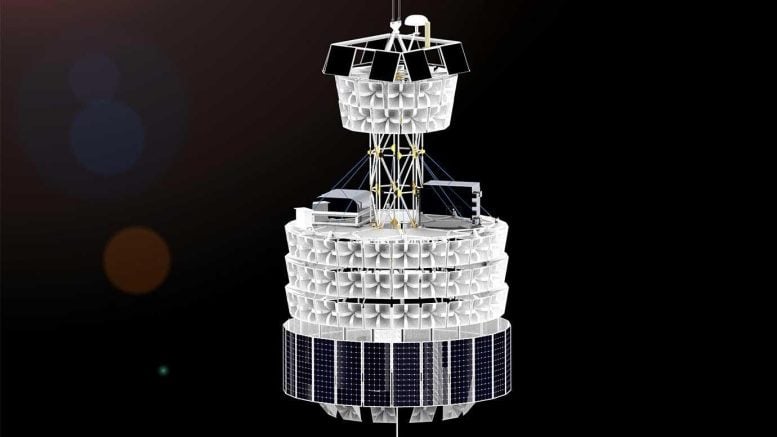To Find the Very Highest-Energy “Ghost” Particles in the Universe, a New Detector Will Soar Over Antarctica

A rendering of what PUEO may look like when deployed. Each white dish is a radio antenna; the signals from each antenna are combined in order to pick up signals from high-energy neutrinos passing through Antarctic ice. Credit: Rendering courtesy of Christian Miki at the University of Hawaii
NASA gives go-ahead for $20M multi-institution balloon experiment led by UChicago scientists.
Sometimes a question is so big that it takes a continent to answer it.
University of Chicago physicist Abby Vieregg is leading an international experiment that essentially uses the ice in Antarctica as a giant detector to find extremely energetic particles from outer space. Recently approved by NASA, the $20 million project will build an instrument to fly above the Antarctic in a balloon, launching in December 2024.
“We are searching for the very highest-energy neutrinos in the universe,” said Vieregg, an associate professor in the Department of Physics. “They are made in the most energetic and extreme places in the cosmos, and these neutrinos offer a unique glimpse into these places. Finding one or several of them could let us learn completely new things about the universe.”

The new NASA-approved project shares its name with the pueo (Asio flammeus), the only living owl native to Hawaii.
The 12-institution international collaboration will build a radio detector attached to a high-altitude balloon, which will be launched by NASA and travel over Antarctica at 120,000 feet, searching for signals from neutrinos. The groundbreaking project is called PUEO, short for the Payload for Ultrahigh Energy Observations. (It shares its name with the only living owl native to Hawaii, where PUEO’s predecessor experiment was born.)
‘A beautiful way to look at the universe’
Neutrinos are often called “ghost” particles because they very rarely interact with matter. Trillions pass harmlessly through your body every second.
Because they can travel huge distances without getting distorted or sidetracked, neutrinos can serve as unique clues about what’s happening elsewhere in the universe—including the cosmic collisions, galaxies and black holes where they are created.
“Neutrinos are a beautiful way to look at the universe, because they travel unimpeded across space,” said Vieregg. “They can come from very far away, and they don’t get scrambled along the way, so they point back to where they came from.”
Scientists have detected a few such neutrinos from outer space coming into the Earth’s atmosphere. But they think there are even more neutrinos out there which carry extraordinarily high energies—several orders of magnitude higher than even the particles being accelerated at the Large Hadron Collider in Europe—and have never yet been detected. These neutrinos could tell us about the most extreme events in the universe.
That is, if you can catch them.
These neutrinos so rarely interact with other forms of matter that Vieregg would have to build an enormous, country-sized detector to catch them. Or she can use one that already exists: the sheet of ice atop Antarctica.
“The ice cap is perfect—a homogeneous, dense, radiotransparent block that spans millions of square kilometers,” said Vieregg. “It’s almost like we designed it.”
Neutrinos can serve as unique clues about what’s happening elsewhere in the universe.
If one of these highly energetic neutrinos comes through the Earth, there’s a chance it will bump into one of the atoms inside the Antarctic ice sheet. This collision produces radio waves which pass through the ice. This radio signal is what PUEO would detect as it floats above Antarctica.
To do so, it needs some very, very special equipment.
The next generation
PUEO is the next generation of a mission called ANITA, based out of the University of Hawaii, which flew over the Antarctic aboard NASA balloons four times between 2006 and 2016 to look for similar neutrinos. PUEO, however, will have a much more powerful detector.
The new detector taps into the power of an old astronomy trick—a technique called interferometry, which combines signals from multiple telescopes. PUEO is studded all over with radio antennas, and a central data acquisition system will merge and analyze these signals to make a stronger signal.

PUEO will launch from Antarctica, as did its predecessor experiment ANITA in 2016 (above). From left to right: scientists Cosmin Deaconu, Eric Oberla and Andrew Ludwig, PhD’19. Credit: UChicago
A stronger signal would be a significant leap forward, because it would help scientists pick out the important signals from the noise washing in from all directions. “There are terabytes of data coming into the detector every minute, and we expect at most a few events out of billions to be a neutrino,” said Cosmin Deaconu, a UChicago research scientist who is working on the software for PUEO. “You can’t write all of that data to disk, so we have to design a program to decide very quickly which signals to keep and which to discard.”
Many common signals look like neutrinos, but aren’t. Those can range from satellite transmissions to someone flicking a cigarette lighter. “At least in Antarctica, there are only a few locations where humans would be generating these, so it’s easier to rule those out,” said Deaconu. “But we even need to account for things like static electricity, generated by wind.”
Vieregg and the team tested the idea of the interferometric phased array on the ground in two experiments: one called ARA at the South Pole in 2018, and another called RNO-G in Greenland in the summer of 2021. Both showed a significant jump in performance over previous designs—which makes PUEO’s aerial detector all the more promising. “PUEO will have a factor of 10 better sensitivity than all previous flights of ANITA combined,” said Vieregg.
“Finding one or several of these neutrinos could let us learn completely new things about the universe.”
— Assoc. Prof. Abby Vieregg
In the next months, the team will build prototypes for PUEO and finalize the design. Once the layout is final, small teams at institutions around the country will build parts of the instrument, which will then be assembled and tested at UChicago. “For example, we want to make sure it can handle the vacuum of near-space,” said Eric Oberla, a UChicago research scientist who is building PUEO’s hardware. “It’s harder to dissipate heat when there’s no air to move it away, which can be a problem for electronics, so we’ll run tests in a vacuum chamber here on campus and later in a large NASA chamber during the instrument integration campaign.”
From there, PUEO will ship to a NASA facility in Palestine, Texas, for final tests before being sent to the launch station in Antarctica.
Depending on the weather conditions, the detector could fly for a month or more, collecting data and transmitting it back to the ground, where scientists will comb through it for evidence of the first-ever high-energy neutrino detection.
“We are delighted to have the PUEO stratospheric balloon mission included in the inaugural group of Pioneers missions, and are looking forward to the great science it will return,” said Michael Garcia, lead at NASA/HQ for the Pioneers in Astrophysics Program, which is funding the experiment.
The Pioneers program allowed the scientists to “dream big,” Vieregg said. “We could say, ‘If we could build anything we wanted to, what could we make?’”
“It’s a discovery experiment, meaning nothing’s guaranteed,” she added. “But all the indications say there’s something out there for us to pick up—and even a few neutrinos would be an amazing scientific find.”
No comments:
Post a Comment